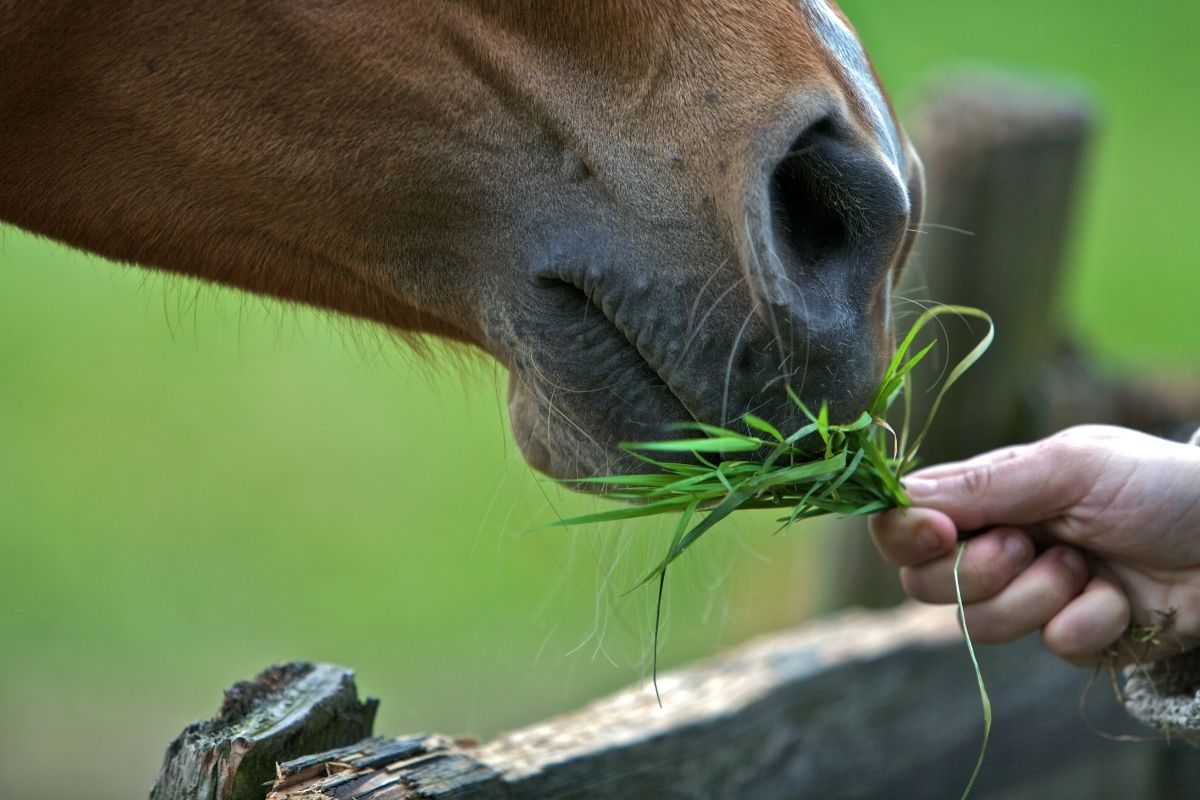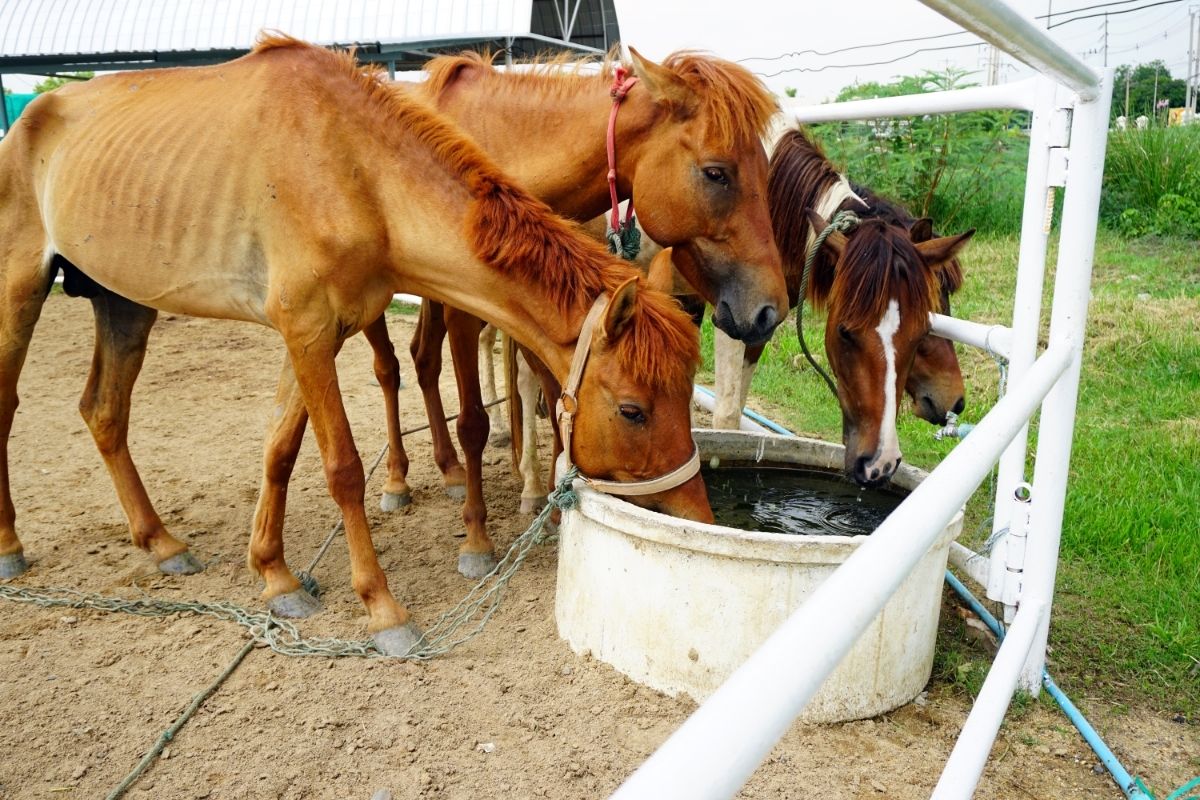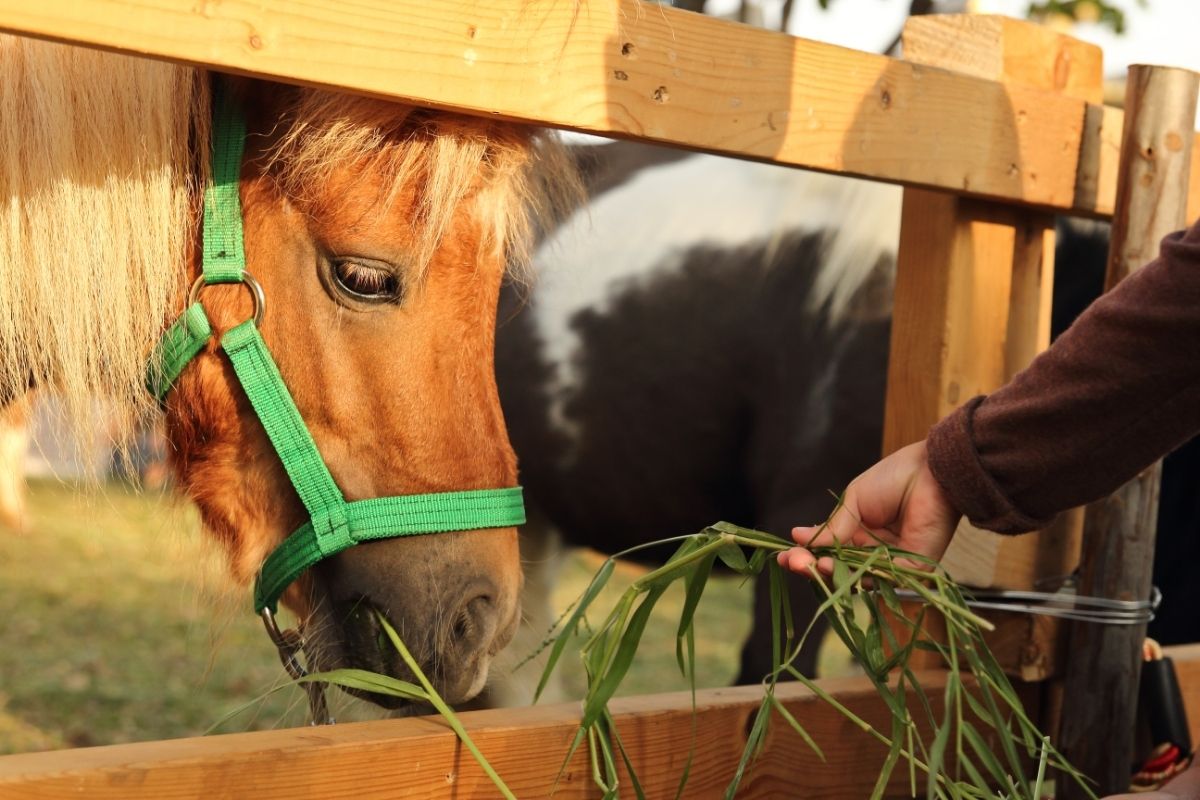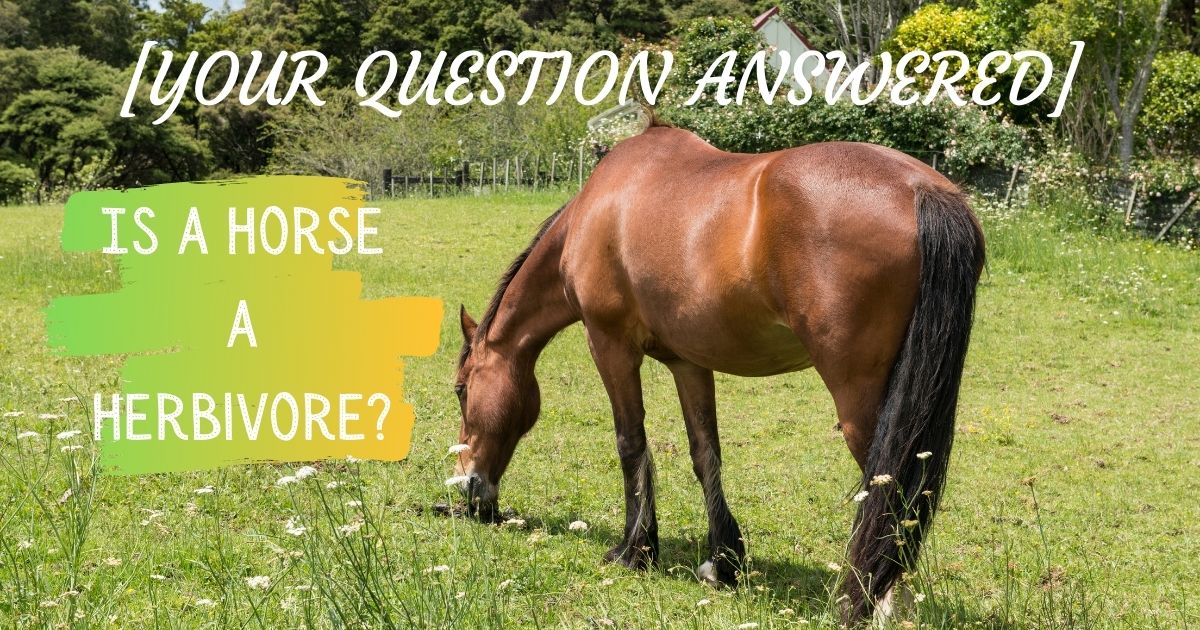What is a Herbivore?
Is a Horse a Herbivore? Herbivores are creatures that only eat plants. These animals have flat grinding teeth and extensive digestive systems adapted to breaking down the stiff cellulose fiber found in plants. This group contains most grazing animals, including cows, bison, zebras, elephants, and antelope, in addition to horses.

Is a Horse a Herbivore?
While learning how to care for them, many horse owners wonder whether their horse is a carnivore, herbivore, or omnivore. Because horses do not have a set sort of diet, you determine their nutrition by their species and, more particularly, the type of horse.
Are horses omnivores or herbivores? The horse and its other equine cousins, such as the zebra and donkey, are omnivores because they eat fish, plants, grasses, grain seeds, fruit, and vegetables.
What do Horses Eat?
Is a horse a herbivore? Horses are herbivores with a digestive tract that differs from ours; they have precise dietary requirements. Their lengthy digestive system needs a high-fiber diet taken in small quantities over a long period.
Horses consume many small meals rather than a few big meals like people do. This is because horses spend most of their time eating.
Here’s a breakdown of what horses consume, as well as what they shouldn’t.
Pasture Grass and Tender Plants
The horse’s natural diet consists of grazing grass and tender plants. Good pasture has most of the nutrition a horse needs to stay healthy. It also has silica, which is beneficial to tooth health. However, some horses can survive on inadequate nutrition and must often do with simple pasture and housing circumstances.
This is likely why obesity, equine metabolic syndrome, and laminitis are uncommon in wild horses but common in domesticated horses. Pasture grass isn’t always the issue; it’s the horses we’ve bred and the lack of activity that are.
If you have easy keepers, you must minimize the fresh grass available to your horses. Good grass gives the optimum nutrients for a hard-to-keep horse.
Hay
Many horse keepers do not have the luxury of allowing their horses to graze on pasture all year round. If the grass isn’t an option, hay is the next best thing. However, it might be challenging to get good horse hay. Therefore, it’s a good idea to have your hay tested so that you can address any vitamin and mineral deficiencies with supplements.
Rich hay can be a problem for specific horses, just as rich pasture grass.
Grains
Horses feed on oats as a traditional grain. Horses can, however, feed on modest amounts of other grains, such as corn. Some grains, such as wheat, are harmful to horses. In their natural habitat, a wild horse’s closest equivalent to consuming grains would be the seed heads of grasses.
Modern-day grains cultivated, harvested, and processed are not natural for horses. It’s simple to give horses too much grain. Grain also doesn’t take the same amount of chewing time or have the same amount of silica grass, leading to ulcers and tooth problems. A horse that overeats grain may get colic.
Concentrate Horse Food Mixes
Grain, flaxseed, beat pulp, molasses for energy and flavor, bran, vitamins and minerals, and other components are part of the concentrates. Some feed mills will combine concentrates for your needs, or commercial mixtures may contain various ingredients (only practical when you have many horses to feed).
Concentrate mixes, like grain, help compensate for any nutritional deficiencies while also providing a rapid energy source. In addition to grass or hay, mares in foal, nursing mares, performance, or working horses often benefit from feeding on concentrates.
Minerals and Salt
Salt and minerals are examples of supplements that you can incorporate in a concentrate mix or sell separately. Horses can help themselves when they have a craving if you place a salt block or lose salt in their pasture or stall. In addition, you may mix minerals with some salt.
Free-choice minerals are also available, or you can mix them into the horse’s grain or concentrate meal. For example, many people discover that horses consume more salt in the summer than in winter.
Treats
Many of us enjoy giving goodies to our horses. Apples, carrots, or other lovely fruits and vegetables, handfuls of grain, sugar cubes, or candies are examples of these tidbits. However, feeding horses meat or too many sugary goodies, like fruit, may not be a good idea.
Are horses herbivores? Horses are herbivores, so even if they don’t show signs of colic when they feed on meat, they may have discomfort, and new diets may disrupt the gut flora.
Water
Water is an essential aspect of the equine diet. A horse that eats pasture grass will generally consume less water than one that eats hay. On the other hand, you require both fresh and pure water.
Plants Toxic to Horses
Wheat and rice bran, for example, are not advised as a significant component of your horse’s diet. These factors can cause mineral imbalances.
The Importance of an Equine Drinking Fresh Water
A horse’s daily water consumption ranges from 640 to 1280 ounces (18 to 36.3 kilograms). That’s a lot of water. If you’re concerned about your horse’s water intake, use a water bucket rather than an automatic water bowl. This is because you can keep track of how much they drink daily.
If you are still concerned about your horse’s intake after taking a record, you should seek veterinarian assistance. Providing fresh, clean water to your horse will help reduce the incidence of colic, maintain body condition, and promote good digestion.
Water can aid horses and ponies in a variety of ways, including:
- The horse requires water for the circulatory system to function.
- Water in saliva works as a carrier for food as it travels through the gastrointestinal tract.
- Excretory Systems: These systems remove waste from the body (urine and droppings).
- Water is required to eliminate tears and mucus by the eyes and nostrils.
- Thermoregulation is the most crucial (sweating).
Dehydration
Weakness, depression, sunken eyes, dry mucous membranes, slower capillary refill time, and elevated heart rate are all signs that your horse may be dehydrated. Pinch the skin near the base of the horse’s neck for two seconds to quickly check the horse’s moisture level.
The horse is not severely dehydrated if the skin returns to normal almost immediately. On the other hand, the horse requires water if the skin remains constricted.
Strenuous exercise or hot weather can cause dehydration. Still, some diseases and conditions, such as diarrhea, fever, acute gastric dilatation, intestinal obstruction, or peritonitis, might compromise your horse’s capacity to keep fluid.
Always keep your horse well-hydrated, and seek veterinarian assistance if you’re unsure about anything.

How Much Should Horses Eat?
Your horse’s health and performance are both dependent on a proper diet. Horses’ dietary requirements are determined by:
- Age, growth, activity, health, environment.
- Calculate how much feed each horse can eat daily. Then you can figure out if you can ingest specific feeds in adequate quantities to meet the nutritional requirements.
- Each day, horses can ingest approximately 1.5 to 2% of their body weight in dry feed (90% dry matter). As a general rule, allow 4 pounds (2 kilograms) of feed per 220 pounds (100 kilograms) of the horse’s body weight.
- However, it is safer to use 1.7% body weight to determine a feed budget. This ensures that the horse consumes the entire amount of feed each day.
For each horse, calculate a feed budget:
- Note the horse’s energy requirements and the energy content of the feedstuffs.
- Calculate the maximum feed intake of the horse.
- Match the horse’s energy requirements to the energy provided by the feed.
- Roughage should account for at least 70% of the meal (hay, pasture, or chaff).
Important points to note:
- Make sure the horse has unrestricted access to high-quality drinking water.
- Make sure you meet the protein requirements. To boost the protein composition of the feed, add protein-rich supplements like lupine or soybean meal.
- Maintenance feed levels rise and fall in cold, rainy weather, returning to normal as the weather warms.
- If lucerne hay is the primary feed, you may require a phosphorous supplement to balance the lucerne hay’s high calcium content. For further information, speak with an equine nutritionist.
- Make feed changes gradually over three to five days, as a quick diet change can induce colic or laminitis.
- You can use a maximum of 10% increase in feed amount when increased horse body weight is necessary. Any feeds more than this may be harmful to the horse. It can take several months for bodyweight growth to be visible.
- Introduce slowly concentrates like grains. They should make up no more than 30% of a horse’s diet.
Suggestions:
- To ensure a balanced diet, taking a vitamin and mineral supplement is recommended.
- Maintain a dental and worming routine to allow the horse to process the feed efficiently.
- Use vegetable oil (or canola, corn, or sunflower oil). Generally, 250ml (1 metric cup) of oil has about the same energy as 5.5 pounds (2.5 kilograms) of oats. Each day, the horse should feed no more than 500ml (2 cups) of oil.
- Slowly incorporate the oil into your diet (increase daily until you reach the desired daily amount). To avoid rancidity, mix into feed just before feeding. Oils can also assist in reducing the amount of dust in the feed.
- When calculating a feed budget for prepared horse foods, please read the label and factor in the energy (MJ, ME, or DE) and protein content.
How to Feed a Horse
Horses should frequently feed throughout the day. If a horse is stable, two to three feeding is required every day. You should not leave your horse without providing for more than eight hours. Horses thrive on consistency, so feed them at the same time every day. Ensure the troughs are clean; otherwise, the horses may refuse to eat or drink.
What do Domestic Horses Like to Eat?
You can determine the amount of food a horse consumes during the day by its size, workload, and age. Daily, most horses consume hay and some concentrates, such as grain or pelleted feed. Turnout horses graze on pasture throughout the day.
The majority of a horse’s diet consists of grass and hay. Horses consume hay and grass continuously throughout the day. Concentrates are given one to two times each day, with the amount and type varied by horse.
What do Wild Horses Eat?
Wild horses graze across large fields, consuming grass, grass seed heads, and other edible shrubs and plants. They want to reside near clean water sources. According to estimates, wild horses may graze for 15-17 hours each day.

Conclusion
Horses are among the last remaining grazing animals globally, eating two to seven times every day. However, the amount of food they consume varies depending on the species and the season. Horses spend the majority of their time grazing in the spring and summer.
Their stomachs are just around four gallons in capacity, so they must consume roughly 14 pounds (6.2 kilograms) of grass per day to stay in shape. Horses eat less as the weather cools in the fall to ensure their bodies maintain their warmth in the cooler conditions.
If a horse is sick, isn’t eating correctly, or is being pushed too hard, grazing times may be cut short and grazed more frequently throughout the day.
When a horse is grazing, it looks for specific grasses and weeds. Clovers, timothy, and orchard grasses are among their favorites, as are grasses found in hay. Horses also enjoy roughage and other weeds, but these weeds are uncommon.
They also eat hay high in sugar but low in protein and calcium and hay that meets various other nutritional requirements.
Are horses omnivores? Horses are not omnivores. Omnivores are animals whose diet contains both vegetation and animals. You can observe Horses’ omnivorous nature when they eat meat. Other people still ask, is a horse a carnivore? A horse is not a carnivore based on feeding and body structure. Carnivores prey on other animals for food.
